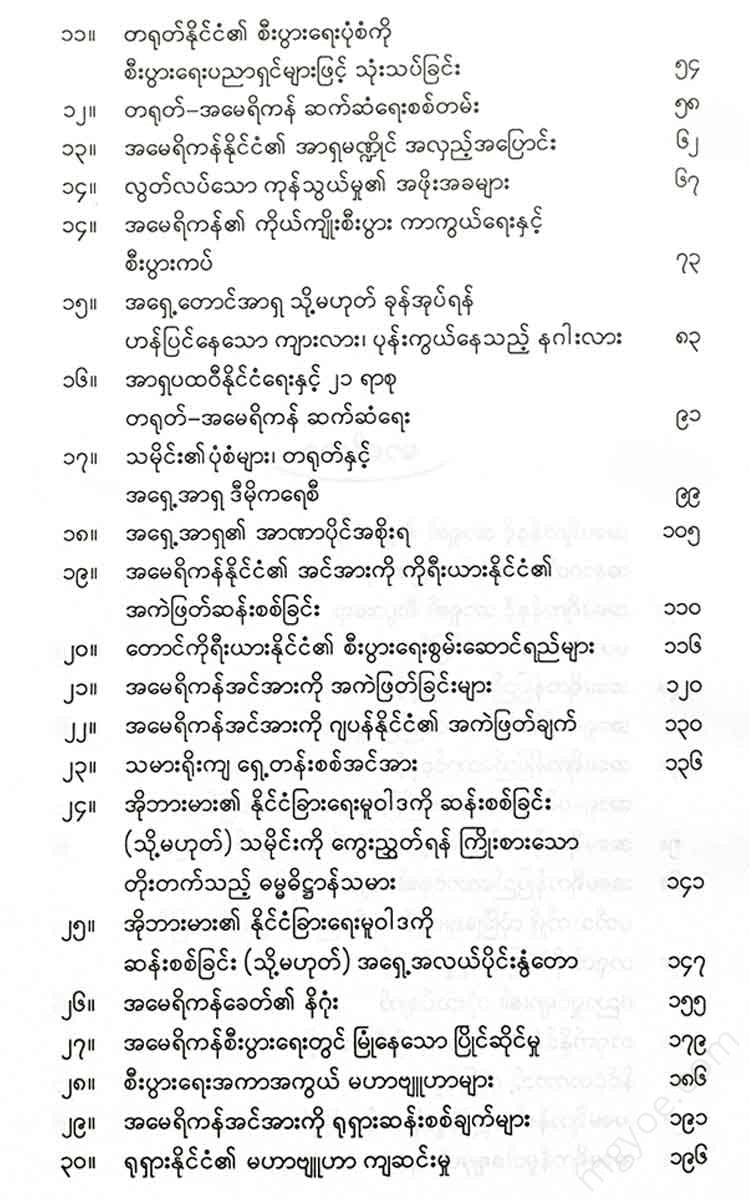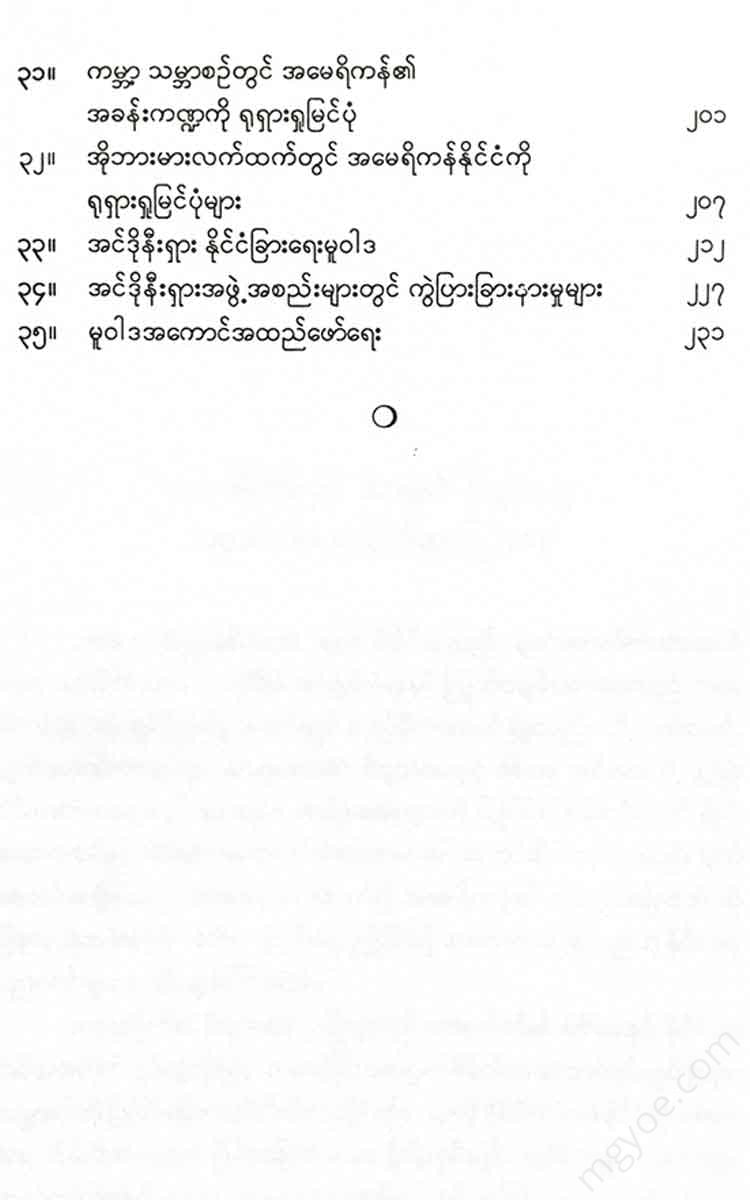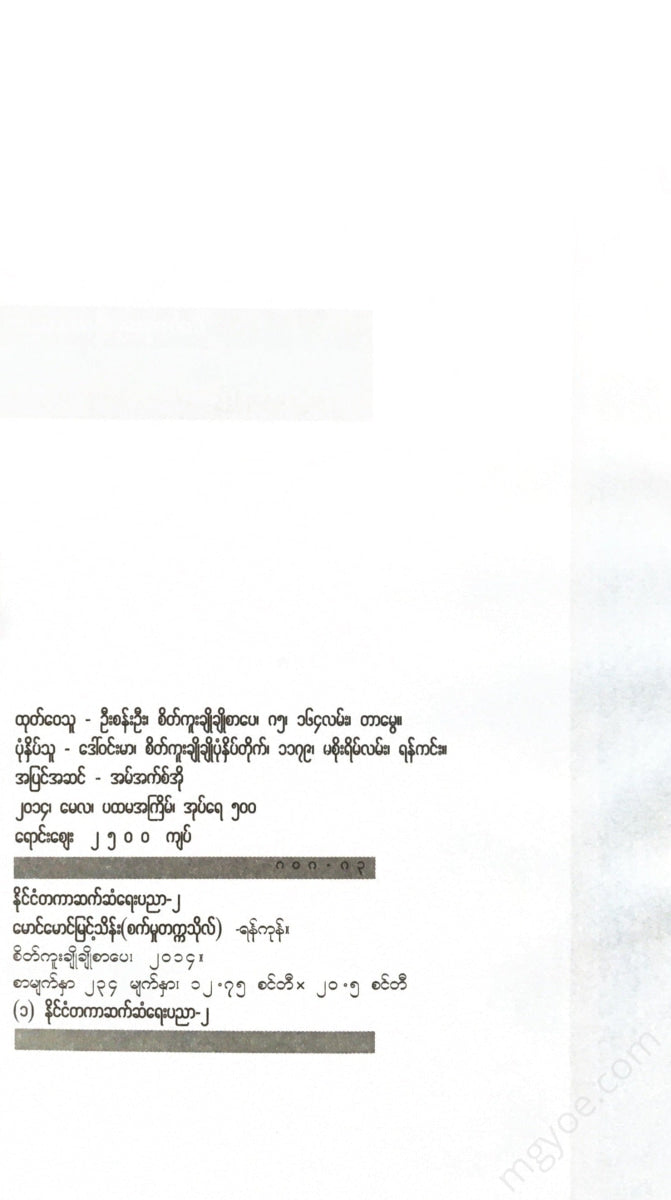စိတ်ကူးချိုချိုစာပေ
Maung Maung Myint Thein (University of Technology) - International Relations IR
Maung Maung Myint Thein (University of Technology) - International Relations IR
Couldn't load pickup availability
The US and Asian economies
Future alliance status
From the post-World War II era until today, the stability and prosperity of the Asia-Pacific region have seemingly depended on the goodwill of the United States. However, the recent growth of Asia’s economic and military power is reshaping the regional landscape and casting a shadow over the US-Asia alliance. Political scientists say that now is the time to reexamine and adjust America’s thinking about Asia.
Asia’s economic growth has also increased its military and political power, transforming the order of influence in the Asia-Pacific region. The region can no longer be viewed in terms of a simple win-win situation where one country threatens to conquer another with military force. The region is increasingly interconnected and interdependent, and economic competition has taken precedence over military competition. Economic power is the key to power. Japan, South Korea, and China (Taiwan), once the dominant Cold War allies of the United States, have become highly developed and have emerged as self-reliant economic powers and democracies. The countries of South and Southeast Asia, particularly India, Indonesia, and Vietnam, are currently in the process of development.
As Asia has grown, the United States’ regional standing has begun to decline. The 2008 global financial crisis and the wars in Iraq and Afghanistan have shown that America’s wealth is not unlimited, nor is its military power unlimited. U.S. policymakers and the American public are already worried about the national debt, which could soar to more than 100 percent of GDP by 2010, and the impact that debt will have on American living standards. Worries about sluggish economic growth at home and the ongoing wars in Iraq and Afghanistan have dampened the desire for major action overseas. A debt review commission has recommended drastic cuts to the Defense Department budget, with upcoming budget cuts likely to affect the ability of U.S. military bases overseas. The United States sees it as a balance of power and a guarantor of security outside Asia (which has helped save Japan and South Korea a lot of money on defense), and reducing U.S. forces would be a major shift in power, both in theory and in practice.
The most prominent power in Asia is China. It is in a position to disrupt the current regional order as it grows to challenge the United States strategically. As China has emerged as a leading economic power, other countries in Asia and around the world have become increasingly dependent on Chinese trade and assistance. China recently surpassed Japan to become the world’s second-largest economy. If it continues to grow at its current rate, it could surpass the United States by 2030. China is the main trading partner of almost every country in Asia, and Asians are increasingly feeling the effects of China’s economic power. Instead of Western loans that often come with rules and regulations for reform, Chinese investment is a more attractive form of aid to developing countries.
This rise in Chinese economic power has complicated power relations throughout the region. Countries are reluctant to engage in full-scale conflict with China if their economic relations are threatened. China has shown that it is not afraid to use its economic power to the maximum extent possible when faced with a conflict. Recently, China pressured Japan by restricting the export of rare Chinese resources in exchange for the release of a Chinese fishing boat captain captured in disputed waters. Many countries have been forced to negotiate with Beijing to develop their economies, even if they are not aware of China’s political ambitions.
China’s willingness to use its economic power for strategic gain is evident in its easy violation of long-standing international norms. China is not committed to global reform or trade liberalization. China’s interests are centered on the control of markets and energy resources through a new trade model that has been completely shaped by the late Maung Maung Myint Thein. While China’s unfettered investment has helped to undermine international pressure on countries like Iran, North Korea, and Sudan to abandon their nuclear weapons or implement democratic reforms, Chinese economic support can only replace what the United States, Europe, or the International Monetary Fund can provide. This reduces the international “squeeze” and punish corrupt governments. In line with this, China has challenged the right to freedom of navigation in international waters by declaring the South China Sea its core territory and defining it as part of its exclusive economic zone (EEZ). China has loudly protested the US military exercises that have made similar declarations in the South China Sea and is staging its own full-scale military parade to demonstrate its growing military might.
While the United States is increasingly concerned about China’s military capabilities, the United States’ view of Asia should not be solely about China and its military situation. To achieve a successful engagement in Asia, it is essential to recognize Asia’s contribution to regional development and its centrality to regional trade. While Asia has prospered under the auspices of the international system that the United States has built and maintained, today’s Asian countries are entangled in political and economic arrangements that the United States has little involvement in. The Association of Southeast Asian Nations (ASEAN) has become an indispensable forum for trade and economic development. Free trade agreements with China, India, Japan, and South Korea are promising avenues for regional economic cooperation. They are also important platforms for discussing regional political and security issues. ASEAN and its related ASEAN+3 and ASEAN REGIONAL FORUM (ARF) are just some of the most established organizations that bring countries closer together economically and, as a result, politically.
This emerging Asian regionalism presents both a challenge and an opportunity for the United States. The United States, which has often directed its foreign policy elsewhere over the past decade, has not been a major driver of this movement, and China is poised to exploit this opportunity. Asia is likely to become the world’s economic powerhouse in the coming years, but the United States is not prepared to establish a new free trade agreement or fully participate in the emerging multilateral economic arrangements in the region. While the Obama administration has made a number of commitments to regional forums and U.S. engagement in Asia, it has yet to reassert its position as a strong Pacific power rather than an interventionist in Asia.











